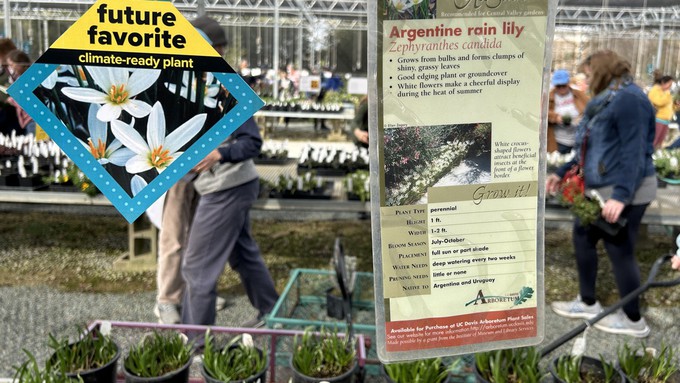
Event features succulents, natives and water-wise perennials; members get in early

Some of the plants sold at the UC Davis Arboretum Nursery carry signs designating them as "future favorites," or plants adaptable to the changing climate. These include Argentine rain lilies. Kathy Morrison
Find hundreds (make that thousands) of possibilities at the UC Davis Arboretum’s Teaching Nursery.
This Sunday, April 7, the arboretum’s 1-acre nursery will host its first public sale of the season. From 10 a.m. to 1 p.m., the sale will be open to everyone. Admission is free.
Want an early start on plant shopping? From 9 to 10 a.m., members of Friends of the Arboretum get first crack Sunday. Not a member? Join at the gate, get at 10% discount and a $10 coupon for the sale.
April is a wonderful time to add water-wise perennials, shrubs, trees and native plants to our landscapes. The weather is warming and so is the soil, which is moist and soft due to recent rain.
Two more sales are scheduled after Sunday: A split sale April 27 and the season-ending spring clearance May 11.
Now available online, the updated inventory list covers 53 pages from four varieties of Abutilon (flowering maple) to three species of Zephyranthes (Argentine rain or zephyr lily). Find it here: https://ucdavis.app.box.com/s/cqttqucpsq1oresaluj2zyz1cpwkf5uf
Also useful is an accompanying photo gallery with hundreds of shots of featured plants. It helps visualize how the baby plants in their 4-inch or 1-gallon pots will look like when fully grown. (Sometimes, that’s much, much bigger.) Atop the gallery are several varieties of mangave, a succulent hybrid of agave and manfreda that’s a favorite for water-wise landscaping.
See the gallery here: https://airtable.com/appGYzBN8THFEAEsX/shrN3Jyghg4NNcK7L/tbl2CPT7gEomY1f0S
Take it from our experience: Research plants before you shop, and compile a list with the plant locations in the nursery. Bring a wagon or rolling cart if you have one. Often early in the sale, there’s a waiting list for the nursery wagons.
The Arboretum Teaching Nursery is located at 1046 Garrod Drive, Davis, on the UC Davis campus near the small-animal veterinary hospital. Parking is available in the adjoining lots. Student volunteers stationed on corners can direct visitors to parking areas.
Details and directions: https://arboretum.ucdavis.edu/.
Comments
0 comments have been posted.Sacramento Digs Gardening to your inbox.
Sites We Like
Garden Checklist for week of July 21
Your garden needs you!
* Keep your vegetable garden watered, mulched and weeded. Water before 8 a.m. to reduce the chance of fungal infection and to conserve moisture.
* Feed vegetable plants bone meal, rock phosphate or other fertilizers high in phosphate to stimulate more blooms and fruiting. (But wait until daily high temperatures drop out of the 100s.)
* Don’t let tomatoes wilt or dry out completely. Give tomatoes a deep watering two to three times a week.
* Harvest vegetables promptly to encourage plants to produce more. Squash especially tends to grow rapidly in hot weather. Keep an eye on zucchini.
* Pinch back chrysanthemums for bushy plants and more flowers in September.
* Remove spent flowers from roses, daylilies and other bloomers as they finish flowering.
* Pinch off blooms from basil so the plant will grow more leaves.
* Cut back lavender after flowering to promote a second bloom.
* It's not too late to add a splash of color. Plant petunias, snapdragons, zinnias and marigolds.
* From seed, plant corn, pumpkins, radishes, winter squash and sunflowers.